Featured Captain: Michelle Bancewicz – No Limits
Months after the Wicked Tuna film crew put away the cameras for the season, Captain Michelle Bancewicz keeps right on fishing.
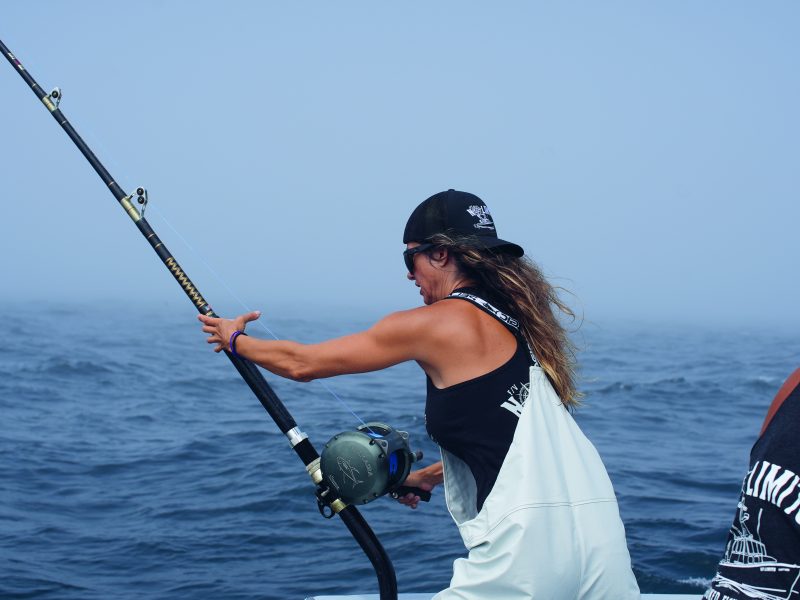
The first thing I noticed when I walked into Captain Michelle Bancewicz’s house was a nautical chart of Jeffreys Ledge, one of the largest feeding grounds for fish in the Northeast, mounted to the wall in the entryway. “It’s my backyard and one of my favorite places to fish,” she said as she welcomed me inside. When the majority of her time between June and December is spent chasing giant bluefin tuna, it’s an inspiring reminder every time she slips on her deck boots to head out and target the toughest fish in the Atlantic. Michelle made us each a cocktail and then took her black lab, Axel, out for a quick walk. I sat down with Kendra, the younger of Michelle’s teenage daughters, and asked what she thought about her mom becoming the first female captain on Wicked Tuna, one of National Geographic’s longest-running TV shows. “I think it’s amazing. It hasn’t been easy for her, getting to where she is. I know everything she does is to show me, my sister, and all women that there really are no limits to what we can do.”
No Limits is the name Captain Bancewicz gave to the 31-foot BHM she bought in 2019 when she decided to commercially fish for giant bluefin tuna on her own.
After a bit of small talk about my snowy drive from Cape Cod to Seabrook, New Hampshire, we started digging into the two days of December tuna fishing ahead of us.
(Note: On The Water is reader-supported. When you buy through links on our site, we may earn an affiliate commission.)
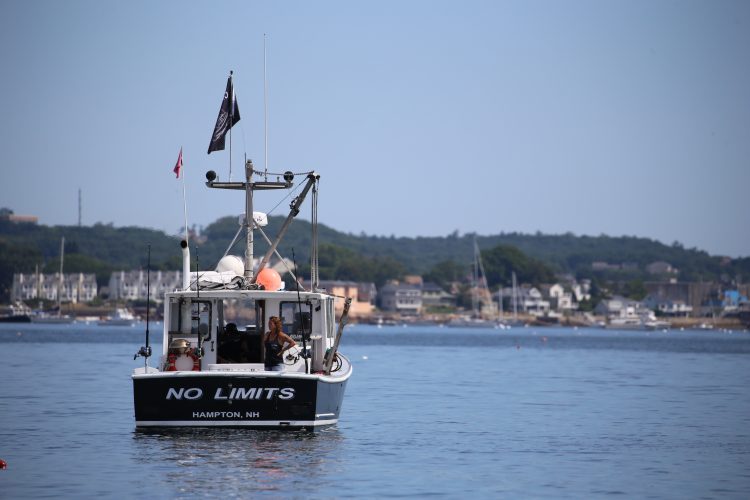
As Michelle spliced the 200-pound Hi-Catch monofilament leader to the Diamond Braid Generation 3 hollow core on her Okuma Makaira 13011-SEa reel, my eyes drifted to the rod-building table across the room.
“I built the table last year. I learned how to build my own rods because I like putting meaning into the details and I can take that with me on the water. I love being able to fish rods that I’ve built,” she said, before telling me to go grab anything I might need from her closet. “We never know how cold it’s going to be until we’re out there, and it’s best to be prepared.” I took her up on the offer and chose an extra pair of socks that she’d received from Pelagic Gear—there’s no time for numb toes on the last tuna trip of the season.
We loaded her truck with the gear we’d take on our trip south the following morning, and set our alarms for 3 a.m. I got a solid two hours of sleep, which is slightly less than the three hours of sleep I typically get the night before a tuna trip, but this trip felt extra special. While I began tuna fishing only in 2022, I’ve gone on almost a dozen trips out of Saquatucket Harbor on Cape Cod. During one of those trips, I heard a voice on the radio say, “Michelle, we have some extra bait. What are your TDs?”
“Turn the radio up! It’s Michelle.” I said, smiling ear-to-ear. It was the only time the entire season that I heard a woman’s voice on the radio.
Michelle and I had talked on the phone quite a bit since April of last year, when I’d seen a video of her catching an 800-pound tuna by herself, and I wrote to ask if I could interview her for an article. Filming for Wicked Tuna ran through September, and our schedules rarely aligned. Still, we got to know each other through phone conversations during those months.
“I’m down at the boat changing the oil. I’ll call you back,” she’d say, or, “I’m taking my daughter to driver’s ed, so give me ten minutes.” She often returned my calls while I was fishing for stripers off the beach on Cape Cod. We’d talk while I held the phone with my shoulder until I hooked up and said, “I’m on, gotta go!”
Michelle grew up in Hampton, New Hampshire, where she began fishing recreationally at a young age with her father and brother. Bluefish and cod were the most common catches on their 28-foot Carver Voyager. As a teenager, Michelle worked as a mate on headboats, and in 2015, she caught her first tuna. Soon after, she got her captain’s license. “My father and brother have their captain’s licenses, so I got mine to prove to them and my daughters that I could.” She began attending fishing seminars that offered hands-on learning experiences and technique workshops, and in 2017, she caught her first tuna as a captain on a friend’s 31-foot BHM.
In one of my first conversations with Michelle, she said, “I feel more at home on the water than I do on land.” I know the feeling. It isn’t that we don’t love our respective lives on dry land—it’s that we feel most ourselves when we are on the water.
As Michelle and I drove into the Hampton River Boat Club, I pulled a couple of headlamps out of my bag so we’d have enough light to load the boat in the dark, then I got out of the truck to meet her first mate, Lea Pinaud. I don’t have a single memory of seeing another female in a tackle shop growing up, and I can count on one hand the number of times I’ve had women fishing on both sides of me on a beach. Now, I was heading out after the biggest and baddest fish in the game as part of an all-female crew.
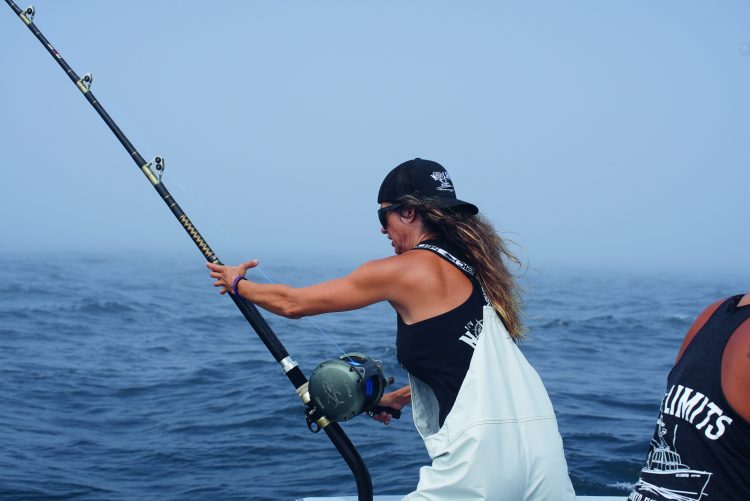
Like Michelle, Lea is a New Hampshire native who grew up fishing for stripers with her dad and brother off the shore of her home state. As a kid, she spent summers in Belfast, Maine, fishing for trout and mackerel with her grandfather. She began tuna fishing in 2019 when she met Michelle, and the two have worked as a team since.
There was only one other boat in the water at the boat club that morning. We moved quickly, and while it didn’t take us long to load the gear, my fingers were already numb. Luckily, there was a heater on the boat, and when the door to the deck was shut, we were able to warm up.
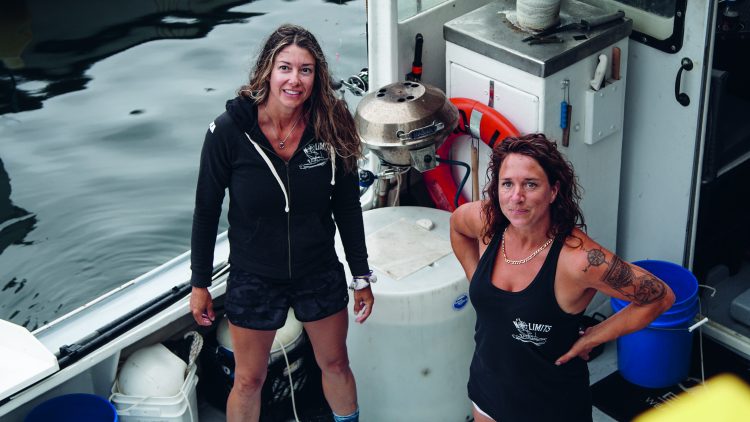
While Lea organized the gear, Michelle got on the radio and checked in with another local captain who was making the four-hour steam to the northwest corner of Stellwagen Bank that morning.
Every captain and crew have their own rules and their way of doing things; many also have their own superstitions. Whether it’s a favorite song played while pushing off, a certain breakfast, or a meaningful object kept in a pocket while out on the water, all of the captains and crew I’ve met have superstitions or rituals … except for the women of FV No Limits. No bananas on board goes without saying, but beyond that, as we made our way out of the harbor, they explained to me that superstition and ritual play little to no part in the success of their trips.
For Michelle and Lea, being prepared, trusting their instincts, prioritizing effective communication, and having fun are the key controllable elements of a successful trip.
However, Captain Bancewicz does have a few rules she lives by on the water. “I like no memory in my leaders, and I clean them with rubbing alcohol. I always recheck the drag on the way out. It took losing just one fish as a result of not setting my drag to learn never to make that mistake again. Generally, I like it set at thirty-five pounds on the strike.”
When it comes to the drag, every tuna captain is different. Michelle’s rationale is that 35 pounds is light enough to leave room for her to bump up the drag for the remainder of the fight after the fish makes its first run, and once she has an idea of what she is dealing with. If you don’t know where your drag is set when you hook a giant bluefin, it can be difficult to determine whether you’re fighting a big fish or if you’re letting a small fish make big runs away from the boat with relative ease. When a tuna is swimming forward, oxygen is passing through its gills and it isn’t losing energy, particularly when an angler isn’t putting pressure on the line. A great captain knows when and how to command choreography between the boat and the fish. Every second that a tuna slows its run or turns its head is an opportunity to close the gap… and it can’t be wasted. Another rule that Captain Bancewicz fishes by is adjusting the drag if she hasn’t closed the gap between the boat and the fish within 45 minutes of the hookset.
We neared Gloucester as the sun peeked above the horizon and decided it was time for breakfast sandwiches. The grill refused to cooperate, but Lea, undeterred, said, “Looks like we’ll have to use the buddy heater.”
I’m a big breakfast-sandwich fan, so it was unusual when, after my first bite, I didn’t immediately take a second. “Here, eat this. It will help,” Lea said as she tossed a mini candy cane at me. The peppermint quickly settled my stomach. The sea state was averaging five-foot waves every five seconds that morning, and luckily, Lea was quick to identify signs of seasickness and made sure I was okay before I’d even had time to mention that I wasn’t going to finish my sandwich.
When it comes to fishing off Cape Cod, from the south side of Stellwagen Bank to the Regal Sword, the presence of whales and pelagic birds are sure indications that tuna are nearby. These areas hold bait that attracts giant schools of bluefin each year.
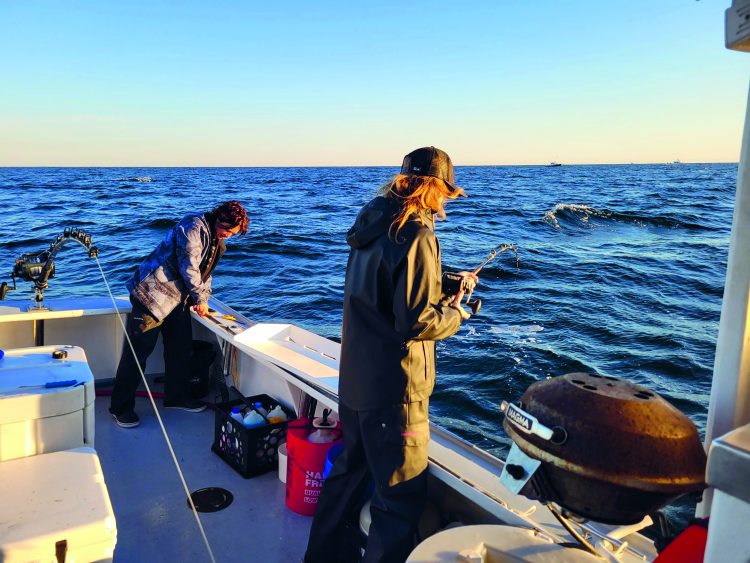
Whales are generally easy to spot and smell, and they are almost always near large concentrations of sand eels or other baitfish. It’s rare to fish for tuna at the Regal Sword or Crab Ledge without seeing birds diving for bait, or hearing, smelling, or seeing whales. Perhaps the only thing that can be said with any certainty when it comes to tuna is if you intend to catch one, you’d better find the bait.
From the northernmost corners of Stellwagen Bank through the Gulf of Maine, fishermen don’t benefit from the temperature breaks that attract forage species traveling the Gulf Stream to the well-known feeding grounds off Cape Cod, but bait is still the key, and Michelle’s strategy was built around that.
Halfway through my second candy cane, we began marking bait so Lea, Michelle, and I took turns on the bait rods. It was a few minutes of relief from the buddy heater and then back out to the deck to catch enough mackerel and herring to get us through the first day of fishing.
As we made our way to the northwest corner of Stellwagen Bank, we spotted a dozen boats, but none appeared to be fighting a fish.
Aside from the obvious difference in pelagic life, or lack thereof, all the boats we saw were anchored. The strong currents east of Cape Cod, difference in depth, and abundance of fish that can rip through feeding lanes in large schools at a moment’s notice in any direction generally demand a drifting strategy. Here, however, on this freezing yet beautiful morning in December, we were primarily reliant on two things—intel from other fishermen and bait, which we found near bumps and drop-offs on the ocean floor.
“I’m going to stick to the outside of these boats,” Michelle said as she scanned the Garmin for bait. “If we hook a fish, I don’t want to have to walk it out of the fleet.”
After several hours of steaming and 20 minutes looking for the right spot, we dropped anchor. Between the fumes from the exhaust and a nauseating wave height-to-length ratio, I wasn’t feeling great. However, Lea kept the energy up as the sun went down; by dusk, the waters had calmed and I was feeling better.
A brief moment of excitement brought us to our feet when a small porbeagle whacked a dead mackerel that Michelle had surgically stitched up and weighted. This “stickbait” was suspended 40 feet off the ocean floor in 145 feet of water.
As the sun set, Michelle had a decision to make—pull anchor and move the boat closer to where we’d heard a couple boats had landed fish that afternoon or stay where we were and wait to see if the tuna made their way to us.
As Tony Soprano said, “More is lost by indecision than a wrong decision.” Michelle lost little time in deciding to pull anchor and move us closer to where the fish had been caught that day, but she took her time deciding where to drop anchor for the night.
There’s an important difference between being indecisive and being deliberate. Michelle’s deliberation eventually uncovered a pile of bait near a small bump on the ocean floor. There, she dropped anchor so that the boat would drift directly above it with the change in tide and wind overnight.
Lea rigged up one of the rods with a live mackerel, then Michelle and I converted the small table she had added cushions to into my bed for the night.
Finally, at 10 p.m., we heard the familiar sound of whales. Michelle and Lea went below deck to get a few hours of shuteye before Lea woke up to put out the lines at 2 a.m. The second my head hit the pillow, a bright light shone through the window, and I sat up to see a large boat approaching us at speed. “Guys, we have company!” I hollered as I threw on my jacket. Michelle ran outside and identified the boat as The Pinwheel, captained by Tyler McLaughlin, fellow member of the Wicked Tuna fleet.
Tyler anchored nearby, one of four boats around us when we went to sleep. By dawn, that number had increased to 16, and by 10 a.m., there were 27 boats in visible range. At that point, the No Limits had drifted to the intended position, remaining surrounded by bait while still being slightly outside where the other boats had anchored up.
Two more members of the Wicked Tuna fleet cruised by and chatted with Michelle on the radio. Despite promising intel and an abundance of bait, the hours rolled by with no word from anyone in the area hooking a fish. Michelle decided that we would pull anchor at 4 p.m. and start the almost four-hour trip back to Hampton so that she could make it upriver during the two-hour window following high tide.
As a two-person crew, Michelle and Lea don’t have the luxury of taking a cat nap at the same time—someone needs to be driving the boat or have eyes on the lines while the other rests. In this case, I was an extra set of eyes and would not have been able to nap even if my life depended on it, so while the girls caught some shut-eye, I stood watch.
I went outside with Michelle’s binoculars and checked on the other boats. Still, it seemed, no one had hooked up. I wasn’t ready to accept that we might not catch a fish.
About 30 minutes into my watch, with no marks on the screen, I decided to take another walk outside and check on the lines. As I turned my head, I saw the rod tip on the outside “floater” bounce ever so slightly. That rod was fishing a live mackerel 30 feet below a green balloon, which was positioned 100 feet portside off the stern. “Hey!” I called down to Michelle and Lea, unsure of what I’d seen. With six hours of sleep in two days and a healthy amount of wishful thinking, it was entirely possible that my eyes were playing a cruel trick on me.
I raced toward the rod. A second bounce. “We’re on!” I yelled. Michelle and Lea were like a couple of firemen, jumping out of their bunks and racing outside as they threw on gear. Lea and I began clearing the other two lines and Michelle jumped on the reel. “Oh yeah, it’s a real one,” she said.
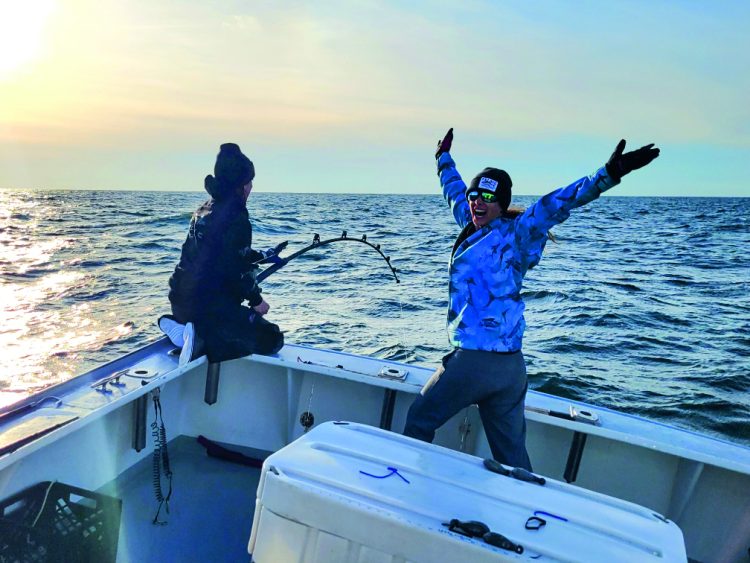
At some point during our nearly 20 hours of downtime, we discussed the order of operations we would follow should we hook a fish—mostly for my benefit, which I appreciated.
On Michelle’s word, I released the line to the anchor ball and put the boat in gear. The water was choppy and the wind had picked up, but Michelle appeared unfazed. Over the next 45 minutes, she and Lea worked together like a well-oiled machine as they closed the gap between the No Limits and the giant bluefin tuna.
Finally, we saw color, though the time between that first sign of color and the cinch of a tail rope feels like the longest moments in a bluefin fight. So many things can go wrong, and after a long fight, they sometimes do. A tired angler may let up pressure on the line, and a tuna will throw the hook and be on its way with a quick shake of its head.
Lea jumped on the reel and Michelle threw the harpoon. “Katie, tail rope,” she said calmly. I felt a moment of relief, followed by pure excitement, then it was back to business. Tuna have a high metabolic rate, so after a long fight, there’s a buildup of lactic acid that needs to dissipate in order to bring high-quality meat to a buyer. As Michelle swam, then bled the fish as we made our way back to find the anchor ball, members of the Wicked Tuna fleet and fellow captains who had seen us hook up began jumping on the radio.
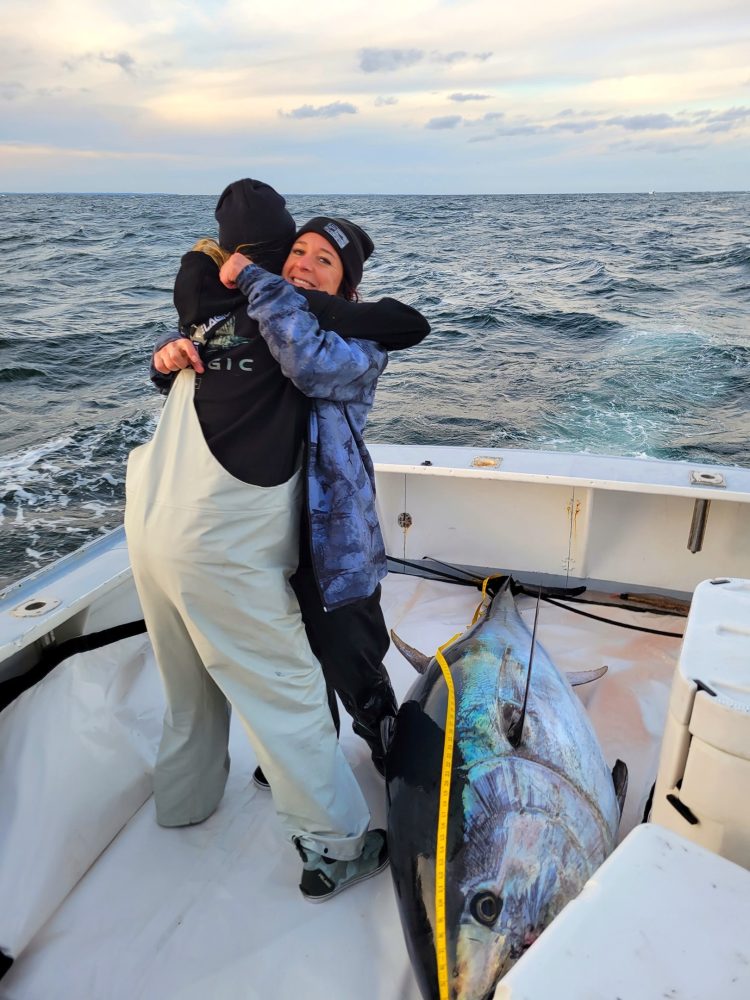
“Nice work, Michelle!”
“Way to go No Limits!”
“Great to see you ladies in action!”
After Michelle and Lea boarded and iced the 92-inch bluefin that would be their last of the season, we set course for Hampton and decided to celebrate with s’mores on the buddy heater.
Fishing for giant bluefin tuna isn’t for the faint of heart. As Michelle said during our trip home, “You need to be able to take a loss on any given day and not let it break your spirit. The very next day, your livelihood still depends on how prepared you are, and how confident you feel about your decisions as a captain.”
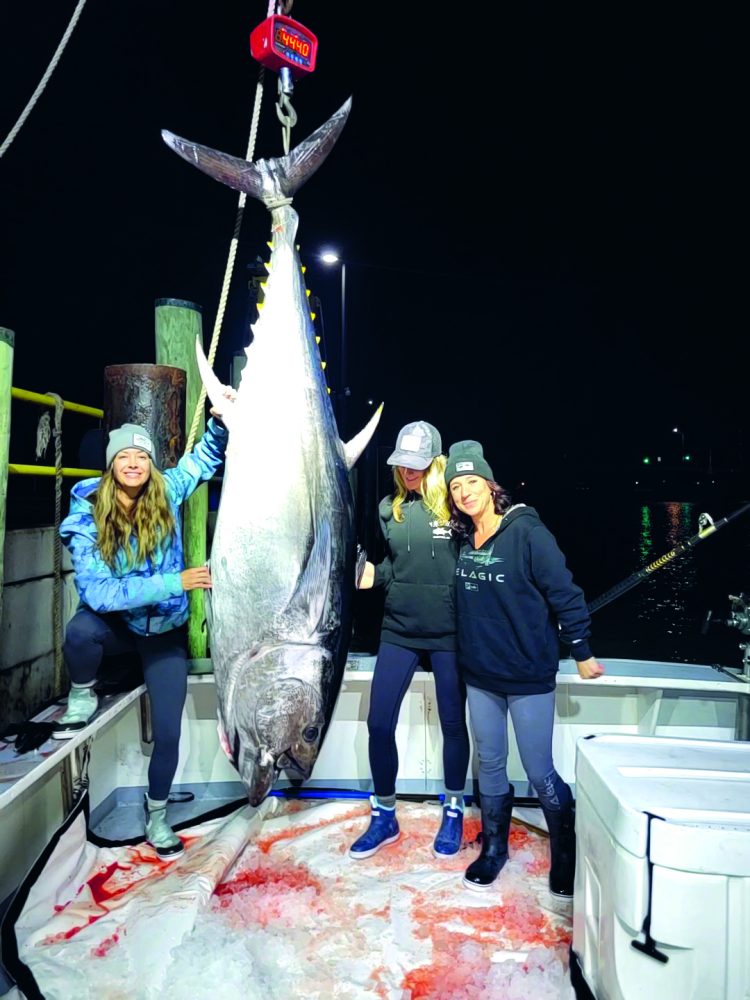
Sometimes, those decisions mean making the 10-hour steam from Gloucester to the Regal Sword to put fish on the boat despite astronomical fuel prices and the fact that you’ve never fished the area—a decision Michelle made that day last summer when I heard her on the radio off Cape Cod while she was filming for Wicked Tuna.
Michelle is fearless in her pursuit of giant bluefin tuna. She is also steady, pragmatic, and not easily discouraged or fazed in her pursuit to be the best at what she does. I was not at all surprised to learn that she had been invited back to the Wicked Tuna fleet for filming Season 14. I look forward to hearing her call “No Limits tight!” on the radio for many seasons to come.
Related Content
9 on “Featured Captain: Michelle Bancewicz – No Limits”
-
Bad News So how much per pound do they actually get? Not the Wicked Stupid Numbers for tv production
-
Carol Love watching Wicked Tuna can’t wait for season 14
-
Don Yeah you’re right Michelle there’s nothing like catching one on a rod that you’ve built. Make sure they spotlight some of your wraps next season so I can steal some ideas 😆
-
-
Nate Great article! I wish them the best. BFT fishing is a great thrill.
-
Robert Great all women crew! I wish them all the luck , they deserve it!!!
-
MARK What a great fishtail. As a lifelong fisherman and the only boy out of a family of nine (eight sisters), I really enjoyed the story. Best of luck to you ladies in the seasons to come
-
Roger Bartlett I really love the 2 woman team, keep it up ladies, finally there is women on Wicked Tuna kicking butt.
-
Tommy Yesssah to No Limits crew
-
Jan You ladies rock! Maybe play Black Betty to get your rhythm going!!!
Leave a Reply